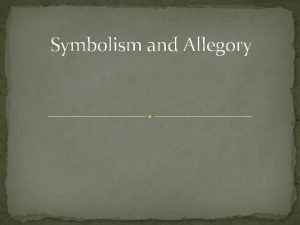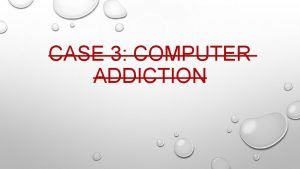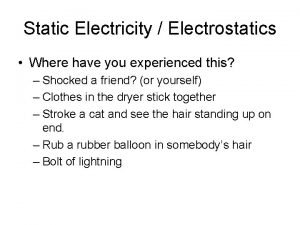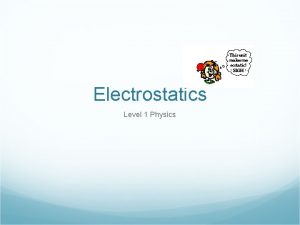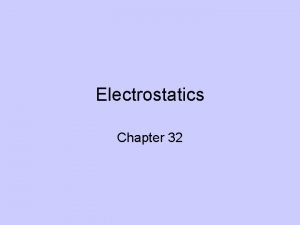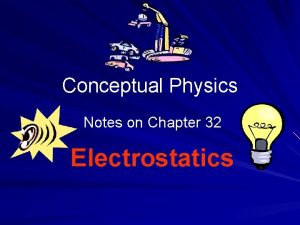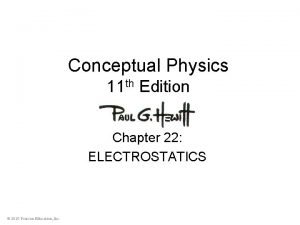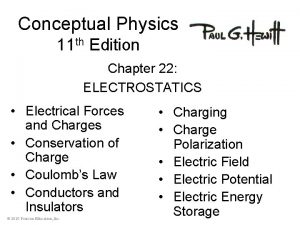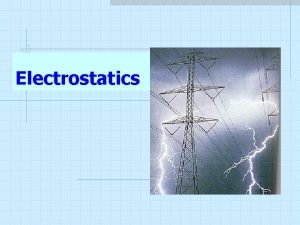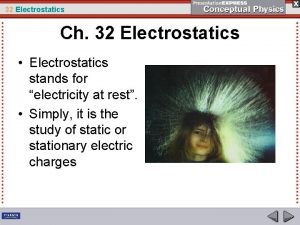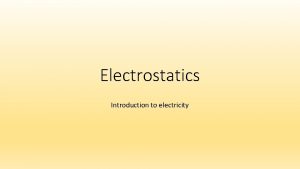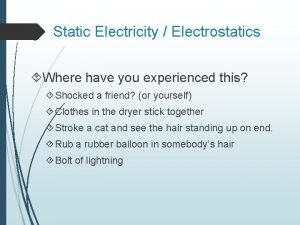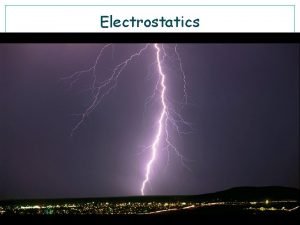Electrostatics Prior Knowledge How have you experienced the












- Slides: 12

Electrostatics

Prior Knowledge �How have you experienced the effects of static electricity?

Electrical Nature of Matter �Incredible as it may seem the act of rubbing a balloon against your hair doesn’t create electrical charges. They were already there! �The fact is that all matter, which contains atoms, always contain electrical charges. The act of moving the charges from their normal position causes the “electricity”.

�Inside of a dryer, your clothes rub against one another and become charged. �On many common substances the charge remains “STATIC”, in other words, the charge stays where the rubbing occurred. This has come to be known as static electricity. • Satellite that get hit with cosmic debris also gain electrical charges that can last for many months.

Electric Charge �A plastic comb and a woolen sweater are both electrically uncharged(neutral). When the comb is rubbed against the sweater they both become electrically charged. �This charged comb can now attract an uncharged piece of paper.

Positive and Negative �There are two kinds of electrical charge: negative and positive. �When two neutral substances rub together, one substance becomes negatively charged and the other becomes positively charged. �With the comb/sweater example the comb become negatively charged while the sweater becomes positively charged, both can now attract most neutral objects, including liquids and gases.

Law of Electrical Charges �Two objects with like charges, whether positive or negative, always repel one another and opposite charged objects attract one another. �This consistent behavior is known as the law of electrical charges. This law states: like charges repel one another, and unlike charges attract one another.

�To determine whether an object is charged and, if it is charged, whether the charge is positive or negative, you must observe the object being repelled by an object with a known charge. �Charged objects will attract both neutral objects and objects with opposite charges. �On the other hand, charged objects will only repel objects with like charges. - - ? attract - - ? repel

The Model for the Electrical Nature of Matter • Scientists believe that all matter is made up of atoms containing particles that possess electric charges. • Two scientists developed a model to help us visualize these particles; Rutherford and Bohr. • The following list of ideas helps us predict how charged objects will behave as well as explain the effects of electrical charges.

Electrical Nature of Matter 1. All matter is made up of particles called atoms. 2. At the centre of each atom is a nucleus, with two kinds of particles: the positively charged proton and the uncharged neutron. Protons do not move from the nucleus when an atom becomes charged. 3. A cloud of negatively charged particles called electrons surrounds the nucleus. When atoms become charged, only the electrons move from atom to atom. 4. Like charges repel each other; unlike charges attract each other.

5. Some elements have a weaker attraction for its electrons than others and the electrons are able to move freely from atom to atom. A good example is copper. Sulfur has electrons that are strongly bonded to its atom. 6. A single atom is always electrically neutral. 7. If an atom gains an extra electron, the net charge on the atom is negative and it is called a negative ion. If an atom loses an electron, the net charge on the atom is positive and it is called a positive ion.

Class Work �Answer the following: 1. Why is the term “static” electricity used? Describe a situation involving static electricity to explain your answer. 2. A photocopier sometimes takes in several papers at once, often causing a paper jam. Why does this happen? What would you suggest to correct this problem? 3. Draw a diagram that explains how electrical charges attract and repel objects. Be creative
 Ya aburnee arabic
Ya aburnee arabic Activating prior knowledge examples
Activating prior knowledge examples Prior knowledge symbol
Prior knowledge symbol Prior knowledge survey
Prior knowledge survey Do boys and girls share the same internet usage?
Do boys and girls share the same internet usage? They have not rejected you but me
They have not rejected you but me Joules in us units
Joules in us units Electric field around a positive charge
Electric field around a positive charge Induction charging physics
Induction charging physics This is electricity at rest
This is electricity at rest Conceptual physics electrostatics
Conceptual physics electrostatics Conceptual physics chapter 22
Conceptual physics chapter 22 Conceptual physics chapter 22 electrostatics
Conceptual physics chapter 22 electrostatics


